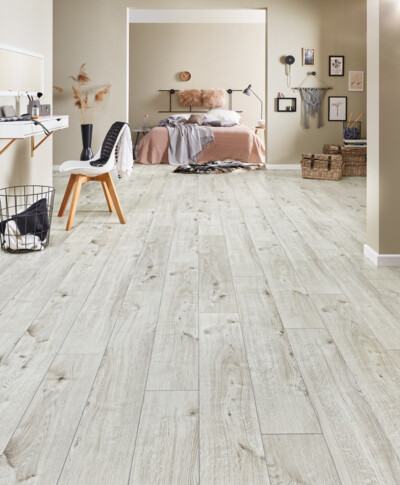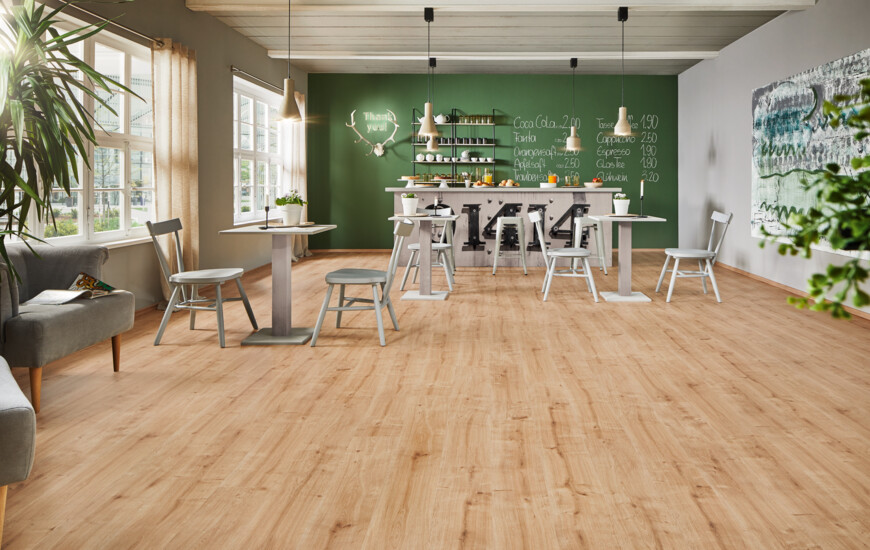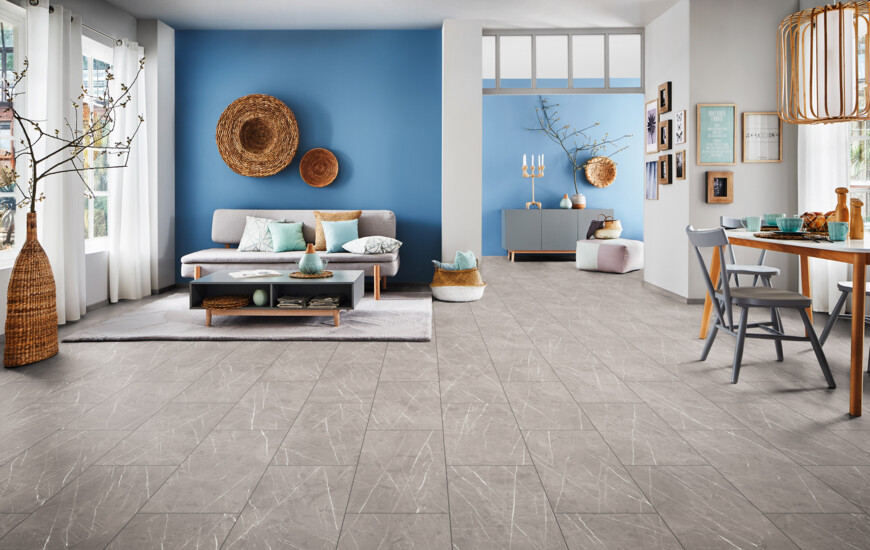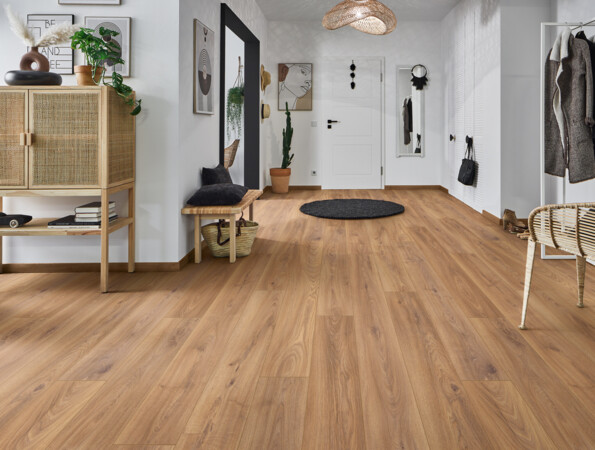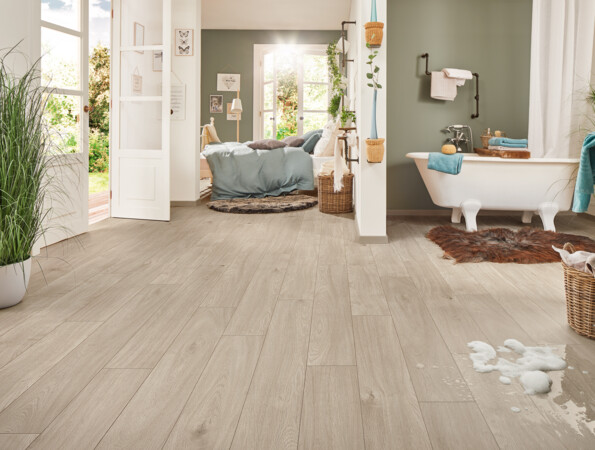Hard vinyl flooring from LOGOCLIC®
Filter
Vinyl flooring – a real all-rounder
If you choose hard vinyl flooring, you are letting a real all-rounder into your home. It is easy to maintain and hard-wearing, has a high load-bearing capacity, is anti-bacterial and looks good at the same time. A versatile, quiet and warm underfoot floor covering that is easy to lay using a click system, just like “normal” laminate. And: our hard vinyl flooring from LOGOCLIC® is also suitable for wet areas thanks to its water-resistant properties.
Properties & advantages of hard vinyl flooring
LOGOCLIC® elementPro also scores in terms of health and walking feeling. This is proven by classification in the best emission class according to the VOC A+ emission scale.
The advantages of hard vinyl flooring at a glance:
- Water-resistant
- Slip-resistant (slip-resistance class 9)
- Particularly hard-wearing (usage class 34)
- Highest indoor air quality A+
- Anti-bacterial surface
- Highly resilient
- High scratch and abrasion resistance
- Perfect floorboard look
- Also suitable for commercial areas
- 30-year warranty for residential use
Hard vinyl flooring or laminate flooring? These are the differences.
The most important difference between laminate and hard vinyl is the raw material. While laminate flooring consists largely of wood, hard vinyl is made of polyvinyl chloride, or PVC for short. PVC is a thermoplastic, elastic and resistant plastic. Vinyl used to have the reputation of containing harmful plasticisers, but this is no longer the case. These are no longer used in the EU, which is why hard vinyl flooring from LOGOCLIC® is completely harmless to health.
Recommendations & tips for hard vinyl flooring
LOGOCLIC® vinyl flooring is a reliable and durable living partner – our product warranty of 30 years for residential use vouches for this. Thanks to its low installation height, you lose very little room height and the practical 1clic2go Pure click system makes hard vinyl flooring particularly easy to lay. Depending on the product, you can choose between a wood or tile look, which creates the deceptively real impression of real tiles or real wooden floorboards thanks to an all-round U- or V-joint.
Can I lay laminate flooring on tiles?
With the right preparation, it is possible to leave the old tiled floor in place. Compared to vinyl flooring, there is no danger with laminate on tiles that the joints on the new covering will show through. To lay laminate flooring on tiles, the subfloor should meet a few requirements:
- The tiled floor should be level
- The tiled area should be dry
- The tiles and the subfloor should be stable
Therefore, before laying, check that the subfloor has a maximum height difference of 3 millimetres per running metre. This value should not be exceeded, as the laminate may yield too much under load at these points and crack, especially in the area of the joints. Smaller uneven areas such as joints between individual tiles can be eliminated with the help of levelling compound.
Would you like to learn more? Then take a look at laminate flooring from LOGOCLIC®.
What is the best way to clean and care for my LOGOCLIC® laminate flooring?
Laminate from LOGOCLIC® is extremely easy to maintain, smooth and sturdy. It is difficult for dirt to stick. For this reason, it is sufficient to vacuum or wipe down with a damp cloth. Fine dust can be removed in no time. This makes simple and straightforward cleaning of the laminate flooring possible. Nevertheless, you should heed a few basic rules to ensure long years of enjoyment of your laminate flooring.
- Before cleaning, the floor should be vacuumed or swept to remove coarse dust and dirt.
- In the next step, the laminate floor is mopped. Here, the rule is: use as little water as possible. Experts call this damp cleaning – only just damp, as if the floor has been wet by a light mist. If too much water is used, the water can collect in the joints, leading to swelling of the coreboard.
- If you like, you can wipe the floor down with a dry cloth afterwards – preventing streaking.
- You can also add LOGOCLIC® laminate cleaner to the cleaning water. This contains additional care substances which serve to maintain the optimum appearance of the laminate floor.
We have underfloor heating throughout the house and cannot drill into the screed. How do we fix the transition profiles?
Two options are available for this:
- Using assembly adhesive: LOGOCLIC® profiles can not only be attached using screws, most profiles are also suitable for the adhesive method. If this is the case, there are special adhesive grooves on the underside of the profiles. These serve to enlarge the adhesive surface. Attach the transition profiles quickly and easily using assembly adhesive (note setting time).
- Self-adhesive profiles: Some of the profiles are also self-adhesive and do not require any external adhesive application. Remove the adhesive film just before attaching the profile, then firmly attach the profile to the expansion joint. Prerequisite for this: the floors to be joined should have the same height.
What is a vapour barrier and why is it needed?
A vapour barrier, also known as a vapour retarder, is essential in preventing water vapour from condensing within thermal insulation or flooring. For laminate flooring, it's typically a polyethylene (PE) film that blocks moisture from rising through the subfloor and damaging the laminate.
Would you like to learn more? Then take a look at the insulation for laminate from LOGOCLIC® and find out about the right products for your project.
Discover our accessories
Can I lay laminate on underfloor heating?
Yes. Due to the high material density, laminate is ideally suited for installation on hot water heating systems. Laminate has optimal thermal conductivity. The heat from the underfloor heating can easily pass through the material and is absorbed very little.
As hot water underfloor heating systems are laid in a screed bed, it is important to carry out a moisture test first and then heat-up according to protocol before laying the laminate.
A vapour barrier is actually always necessary between the screed and the laminate. Whether you need additional impact sound insulation, and if so, what kind, depends on the laminate for underfloor heating. The best solution here is a laminate floor such as Silentos (thermal resistance: 0.103 m²K/W) with its extreme thermal conductivity and only 0.3 mm material thickness. For more information, see the topic insulating underlay for underfloor heating. Do you want to learn more about insulation?
How thick is laminate?
Laminate from LOGOCLIC® can be bought in different thicknesses. Starting from laminate 7 millimetres thick through to 10 millimetres thick and sizes in between. When choosing, personal needs and requirements should be balanced with the properties of the respective ranges.
Would you like to learn more? Then take a look at laminate flooring from LOGOCLIC®.
Is it possible to install laminate flooring over PVC?
Yes, it's often possible! When laying laminate over PVC, a separate vapour barrier is unnecessary if the PVC is dry. However, we highly recommend using impact sound insulation for optimal results. Discover all the necessary materials and accessories for your installation within the LOGOCLIC® range, available at the BAUHAUS specialist centre.
What type of underlay should I use when laying laminate on wooden floorboards?
When installing laminate over old wood, avoid polyethylene film to allow moisture exchange between the laminate and floorboards. Address any unevenness with a thicker underlay like XPS Maxima or wood fibre boards. LOGOCLIC® offers various underlays, including impact sound insulation, vapour barriers, and thermal insulation. Consider our Pro Acoustic Light+, an all-in-one solution that acts as a vapour barrier, provides impact sound insulation, and levels the surface.
Would you like to learn more? Then take a look at insulation.
Can I lay laminate flooring on tiles?
With the right preparation, it is possible to leave the old tiled floor in place. Compared to vinyl flooring, there is no danger with laminate on tiles that the joints on the new covering will show through. To lay laminate flooring on tiles, the subfloor should meet a few requirements:
- The tiled floor should be level
- The tiled area should be dry
- The tiles and the subfloor should be stable
Therefore, before laying, check that the subfloor has a maximum height difference of 3 millimetres per running metre. This value should not be exceeded, as the laminate may yield too much under load at these points and crack, especially in the area of the joints. Smaller uneven areas such as joints between individual tiles can be eliminated with the help of levelling compound.
Would you like to learn more? Then take a look at laminate flooring from LOGOCLIC®.
How durable is laminate flooring?
The longevity of flooring is a key factor in your decision. LOGOCLIC® laminate is crafted for high quality and exceptional durability, backed by a warranty of up to 30 years. Discover more about the specific advantages that make LOGOCLIC® laminate a lasting choice.
What needs to be taken into account for the direction in which laminate is laid?
The direction in which laminate is laid refers to the orientation of the individual panels in relation to the walls.
- Longitudinal direction means alignment parallel to the long side of the room.
- Transverse direction is parallel to the short side of the room.
- Diagonal describes alignments that are not at right angles to a wall.
Since there is a lot of work involved in laying laminate and you want to enjoy your floor for a long time, you should consider in advance how you want to lay the floor.
We will be happy to give you tips on how to lay laminate.
We have underfloor heating throughout the house and cannot drill into the screed. How do we fix the transition profiles?
If underfloor heating is present, it is not possible to simply drill into the screed and alternative fastening techniques are necessary. But here too, LOGOCLIC® provides a remedy thanks to its product variety of adapter and transition profiles.
Using assembly adhesive: LOGOCLIC® profiles can not only be attached using screws, most profiles are also suitable for the adhesive method. If this is the case, there are special adhesive grooves on the underside of the profiles. These serve to enlarge the adhesive surface. Attach the transition profiles quickly and easily using assembly adhesive (note setting time).
Self-adhesive profiles: Some of the profiles are also self-adhesive and do not require any external adhesive application. Remove the adhesive film just before attaching the profile, then firmly attach the profile to the expansion joint. Prerequisite for this: the floors to be joined should have the same height.
Discover also our range of accessories.
What laminate formats are available?
Modern laminate flooring offers diverse appearances and formats to suit any space. You can choose from long floorboards, narrow panels, and standard laminate sizes. Here are some common dimensions:
- Standard panel format: 1285 x 192 mm
- Thickness options: 7 mm, 8 mm, 9 mm, and 10 mm
- Width options: 192 mm (e.g., Family laminate flooring) and 327 mm (e.g., Vinto laminate flooring)
- LOGOCLIC® also offers the Vinto longboard at 2000 mm, providing the look of traditional floorboards.
At LOGOCLIC® you will find different formats of laminate flooring.
